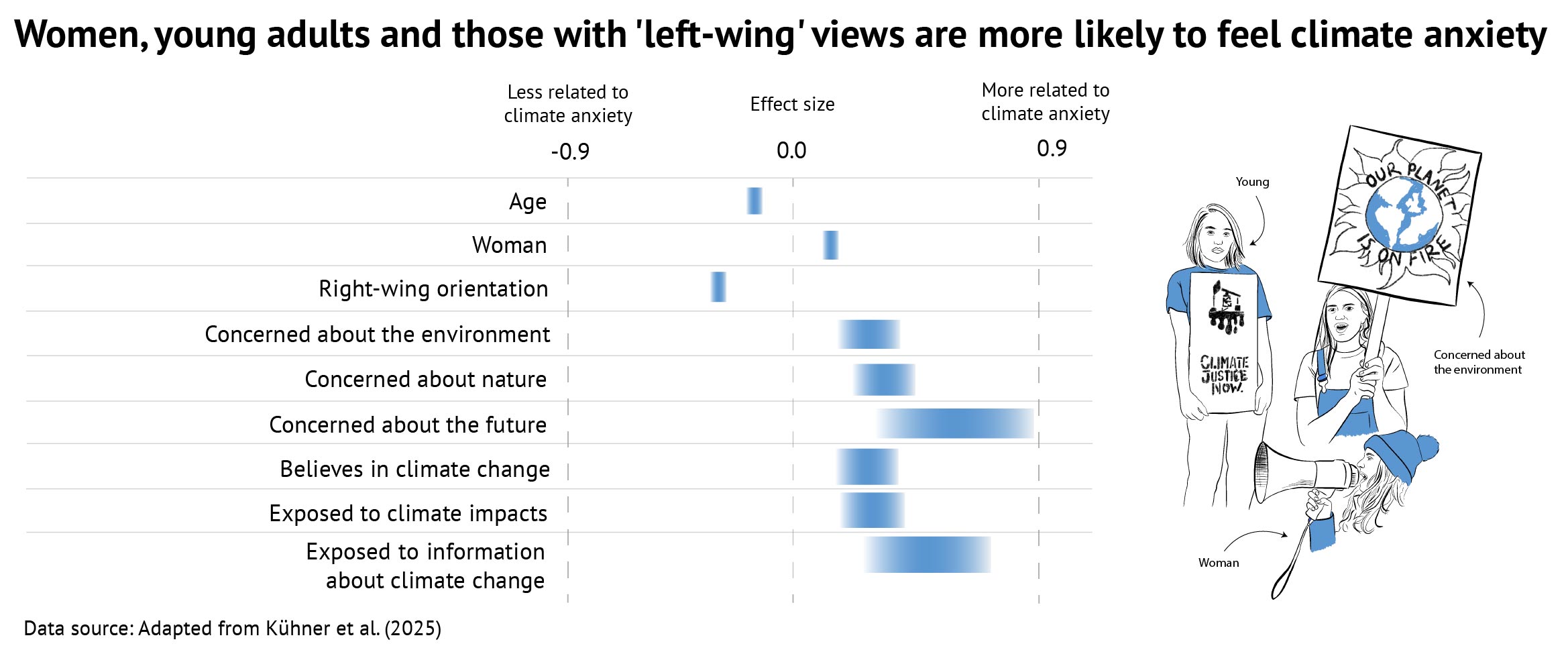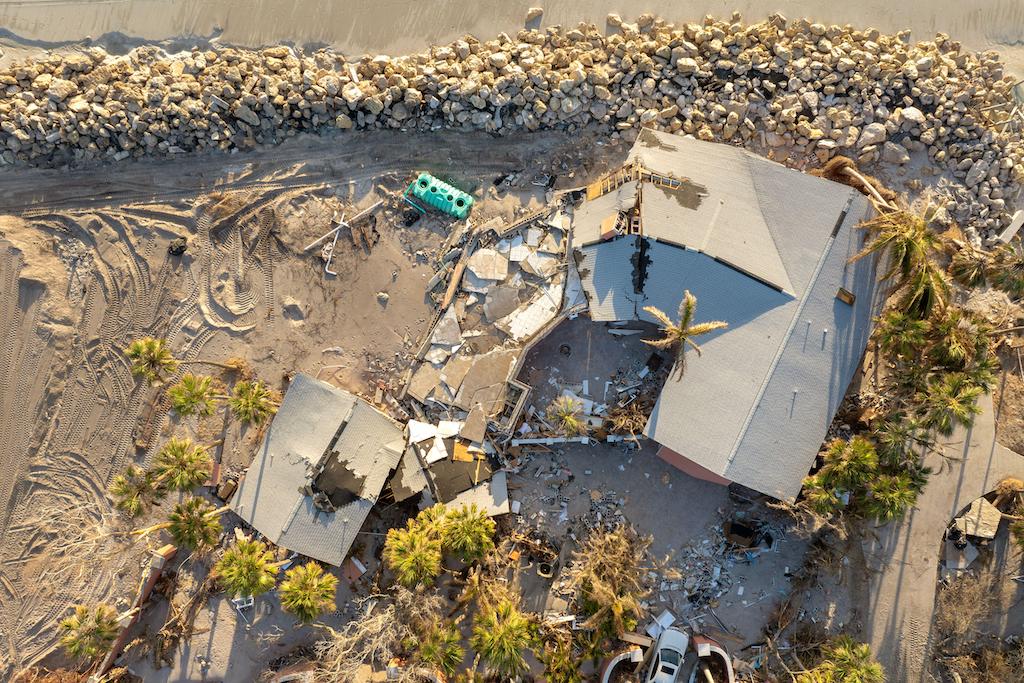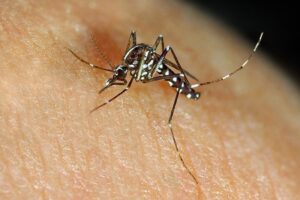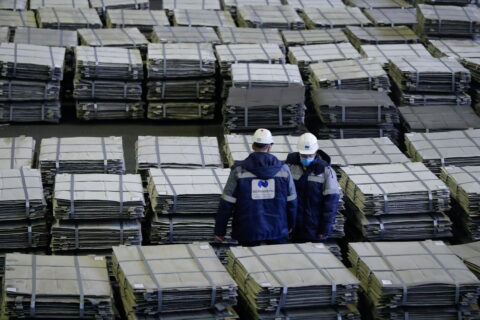As temperature records are shattered, ice rapidly melts and extreme weather events worsen, many people around the world say they are feeling more worried about climate change.
Researchers call this growing phenomenon “climate anxiety”.
A new analysis examines 94 studies focused on climate anxiety, involving 170,000 people across 27 countries, to explore who it is most likely to affect and what its possible consequences could be.
It finds that those who are more likely to experience climate anxiety include women, young adults, people with “left-wing” views and those expressing “concerns” about nature or the “future”.
Climate anxiety is negatively related to wellbeing, according to the analysis, but positively related to participating in climate action, such as activism and behaviours to reduce emissions.
Below, Carbon Brief explains the findings in more detail.
- What is ‘climate anxiety’?
- Who suffers from climate anxiety?
- What are the consequences of climate anxiety?
- How does climate anxiety differ from general anxiety?
What is ‘climate anxiety’?
“Climate anxiety” can be described and defined in various ways.
The research, published in the journal Global Environmental Change, considers the term “climate change anxiety” to “broadly refer to people’s feelings of anxiety and/or worry related to climate change”.
This is based on two established definitions, explains study lead author Dr Clara Kühner, a researcher of climate change and psychology at the University of Leipzig, Germany. She tells Carbon Brief:
“There is a discussion in the scientific community about what exactly constitutes climate change anxiety.”
The first definition comes from a 2023 research paper, which describes climate anxiety as “persistent anxiety (apprehensiveness) and worry about climate change”.
The second comes from the American Psychological Association, which in 2020 used the term “eco anxiety” to describe “any anxiety or worry about climate change and its effects”.
Kühner explains that “eco anxiety could be interpreted as being more broadly related to the ecological crisis…but [the American Psychological Association] describe it as any anxiety or worry related to climate change”.
Her team noticed that there has been an “increasing amount of research” into climate anxiety over the past few years, she adds:
“Research on the topic has exploded. That’s a signal that it’s very relevant to researchers, but also to society and the public.
“But it was very difficult to get an overview of this research because it was scattered across different disciplines, not only psychology, but also public health and sociology. And so it was difficult to really know how much is out there. That’s when we thought: ‘OK, let’s put all of that together in a quantitative meta-analysis to get an overall perspective on the topic.’”
For the meta-analysis, Kühner and her team searched online records, scoured scientific conference agendas and contacted other scientists to try to identify all published and upcoming studies looking into climate anxiety.
They focused on studies that had conducted surveys with people self-reporting symptoms of climate anxiety. They also restricted their search to “correlational studies” looking at the links between self-reported climate anxiety and various factors, such as gender, age or political beliefs.
In addition, they only included studies involving people over the age of 18.
In total, the meta-analysis identifies 94 climate anxiety studies, involving 170,000 people in 27 countries.
Some 81 of these studies were published after 2020, according to the researchers – reflecting the surge of research interest into the topic over the past few years.
Who suffers from climate anxiety?
As part of the meta-analysis, the researchers looked across the 94 studies to identify what characteristics are most highly associated with having climate anxiety.
From this, the meta-analysis finds that those more likely to report feeling climate anxiety include:
- Younger adults
- Women
- People with a “left-wing” political orientation
- People concerned about the environment
- People concerned about nature
- People concerned about the future
- People who believe in climate change
- People who have been exposed to climate impacts
- People who are regularly exposed to information about climate change (such as climate scientists, journalists and teachers)
The graphic below shows the relative “effect size” of each of these characteristics, according to the study, with -0.9 illustrating the trait is less related to climate anxiety and 0.9 indicating it is more related.
On the graphic, the centre of each blue bar represents the effect size, with the start and end showing 95% confidence intervals.

By contrast, people with the opposite characteristics to those listed above – for example, those that are older, male or hold “right-wing” political views – are less likely to report feeling climate anxiety, according to the research.
The study only examines the correlations between feeling climate anxiety and various human characteristics – and does not look into the reasons why different groups of people may be more likely to experience climate anxiety.
One of the research papers cited in the meta-analysis finds that people under the age of 25 who reported climate anxiety were likely to have feelings of “betrayal” aimed towards older generations and to perceive governmental response to climate change as “inadequate”.
On gender, previous research – not cited in the meta-analysis – has found that women are more likely than men to suffer from mental illness following extreme weather events – and face higher health risks from climate change in general.
The meta-analysis does not look into how being transgender or non-binary could be associated with climate anxiety, but researchers have previously argued that these groups – along with other people who might identify as LGBTQ+ – are likely to face disproportionate climate risks.
The meta-analysis also does not investigate where in the world levels of climate anxiety could be the highest.
Most of the papers included in the meta-analysis were conducted in the global north.
Out of the 94 studies, 56 were conducted in Europe, 12 in North America, seven in Australia and New Zealand, seven in Asia, one in Africa and one in South America. (A further 10 spanned multiple continents.)
This “largely reflects the general dominance of western research in mainstream psychological and behavioural studies” – rather than a weakness of the authors’ methods, says Prof Kim-Pong Tam, an environmental psychologist from the Hong Kong University of Science and Technology, who was not involved in the meta-analysis.
He describes the findings as “very significant”, adding:
“It should be noted that the pattern revealed in this meta-analysis does not necessarily indicate that the phenomenon of interest has rarely been studied in the global south or outside of western societies.
“It is common practice for authors conducting a meta-analysis to focus on publications in the language(s) in which they are proficient. This implies that studies published in non-English languages (usually in local journals), if any, are excluded.”
Dr Charles Ogunbode, an associate professor in psychology specialising in how people respond to environmental change at the University of Nottingham, UK, agrees that the “lack of studies from Africa and other parts of the global south is not a unique weakness of this article”.
He says that the “climate anxiety discourse is western-centric”, explaining:
“Outside of western cultures, climate anxiety may not feel like an especially useful concept for making sense of local lived realities. For example, one study found that feelings of anger and grief regarding climate change are more prominent in Turkey. Another study conducted with young people in three African countries found the predominant emotions to be akin to a helpless pessimism. Similar observations were made in Ecuador.
“It is, of course, valuable to have a comprehensive study on climate anxiety, but the western-centric nature of the concept means that we end up missing out on the nuanced cross-cultural dimensions of emotional responses to climate change.”

What are the consequences of climate anxiety?
As well as examining what human characteristics are most associated with climate anxiety, the meta-analysis explores what consequences are most associated with the phenomenon.
These consequences are grouped into three categories: “wellbeing”, “climate change emotions” and “behaviour”. (The meta-analysis considers “wellbeing” to be “how individuals evaluate the quality of their own lives, including experiences such as life satisfaction”.
The meta-analysis finds that feeling climate anxiety is associated with poor wellbeing and negative feelings about climate change.
However, climate anxiety is also associated with “pro-environmental behaviours”, such as saving energy at home, as well as participating in community activism and showing support for government pro-climate policies. Kühner explains:
“We found that climate change anxiety is a double-edged sword. It [is] related to poorer wellbeing and to more psychological strain. On the other hand, it [is] positively related to different forms of pro-environmental behaviour.
“On the one hand, it could make you feel uncomfortable. But, on the other hand, it may trigger significant action.”
How does climate anxiety differ from general anxiety?
One of the goals of the meta-analysis is to investigate if climate anxiety is a distinct psychological phenomenon – or merely reflects the broader recent trend of rising levels of anxiety across many parts of the world, particularly for younger demographics.
To do this, the researchers carried out a “meta-regression analysis”, a statistical method for, in this case, investigating the size of the impact of various factors on having climate anxiety.
This analysis finds that the characteristics associated with climate anxiety, such as being a young adult or female, as well as its associated consequences, such as taking action to reduce emissions, were “uniquely related to climate anxiety above and beyond generalised anxiety”. Kühner explains:
“From a methodological point of view, this means that these are distinct constructs, not that people who are generally more anxious are also more anxious about climate change.”
This finding could have implications for how both medical professionals and the public view climate anxiety, she continues:
“Sometimes, climate change anxiety is treated like a disease that has to be cured. And it’s not. It’s a normal healthy reaction to an actual threat.
“I think it’s important for policymakers, also journalists and politicians, not to pathologise climate change anxiety, but to interpret it as a functional reaction to something that is actually happening. Instead of offering mental-health support for how to get rid of this, we need more opportunities to channel this anxiety into climate change action.”
In some cases, climate anxiety can cause poor mental health, she adds:
“If [climate anxiety] impairs your daily functioning or affects your sleep, you definitely need mental-health support to cope with these strong emotions.”
In the UK, mental-health support is available from the NHS by calling 111, the charity Mind is also available on 0300 123 3393. In the US, call or text Mental Health America at 988 or chat 988lifeline.org. In Australia, support is available at Beyond Blue on 1300 22 4636, Lifeline on 13 11 14 and at MensLine on 1300 789 978.
The post Explainer: What is ‘climate anxiety’? appeared first on Carbon Brief.
Climate Change
Outdated geological data limits Africa’s push to benefit from its mineral wealth
Resource-rich African nations risk missing out on the investment needed to extract and refine their mineral wealth into high-value products for the clean energy transition because they lack accurate information on what they have, experts are warning.
African countries have attracted huge interest as the world scrambles to access the minerals and metals needed for the energy transition and digital and military technologies, with investors from the US, China, the United Arab Emirates and Europe jostling to secure access to the continent’s resources.
But any knowledge of Africa’s mineral wealth is, at best, an estimate based on century-old-mapping and haphazard geological data, policy experts and investors told Climate Home News.
The United Nations says Africa is home to 30% of the world’s mineral reserves, including cobalt, copper, lithium and manganese, which are needed to manufacture batteries and other clean energy technologies.
But experts like Bright Simons, who tracks natural resource spending in Africa for the Ghana-based IMANI Centre for Policy and Education, said the 30% number is not backed by any “empirical, evidence-based assessment” of the continent’s mineral wealth. While some analysts like Simons think the figure could be an overestimate, others argue it is likely an underestimate of the continent’s mineral reserves.
Up-to-date and accurate data is critical for governments to negotiate better deals with prospecting mining companies and to help drive investment in mineral extraction and processing facilities that can add value to the continent’s resources.
But the lack of good mapping has negatively impacted the continent’s efforts to capture the economic benefits of booming mineral demand and to create jobs by extracting and processing raw materials into higher-value products before export, experts said.
Colonial maps
Under-exploration and scant information about Africa’s resources have made it challenging for states to attract investment and develop their resources, said Pritish Behuria, a political economist at the Global Development Institute at the UK’s University of Manchester.
“In many cases, former colonial powers retain more current knowledge of the kinds of mineral deposits that exist in African countries – and often, this has proven difficult to access for African governments,” he told Climate Home News.
Thabit Jacob, a researcher of extractive and energy resources at Roskilde University in Denmark, said many African countries “still rely on colonial maps”.
“There’s a growing realisation that Africa must know its true value in mineral richness and investment in geological mapping is crucial,” he added.
Mapping inequality
However, mapping investment is falling short. Africa’s share of global exploration investment has fallen in the last two decades, data shows.
In 2024 alone, both Canada and Australia received significantly more investment in geological mapping than the whole of Africa, even though the continent’s landmass is three times the size of the two countries combined, according to the Center for Strategic and International Studies.
Even in South Africa, a major mining destination, only 12% of the country has been mapped at a detailed level “which compares poorly with other popular mining destinations such as Canada and Australia where there is near complete coverage at similar scales”, explained Tania Marshall, of the Geological Society of South Africa.
Nigeria’s push to cash in on lithium rush gets off to a rocky start
To address the dearth in data, multinational institutions like the World Bank have provided African countries with finance for mapping, but have simultaneously encouraged them to liberalise and privatise their mining industries.
As a result, international investors prioritising project development have come to dominate the continent’s mining sector, crowding out state-sponsored initiatives with stronger incentives to invest in data-gathering, researchers have found.

Digging blind
Orina Chang, an investor leading geological mapping across Somaliland, which has reserves of copper and zinc ore, said she was surprised to find out that even countries attracting huge interest from institutional miners, such as the Democratic Republic of the Congo (DRC), do not have systematic up-to-date mapping.
Instead, mining firms rely on artisanal mining and surface signs, like exposed ores on the ground – and crossing their fingers, she told Climate Home News.
The mapping deficit means there is little certainty on the size and quality of mineral deposits and provides few incentives for miners to invest in processing plants, Chang explained.
“Without mapping, everyone is blindly digging and you just get people who are not interested in really investing in your country,” she said. “With mapping, you’re able to attract much better players and build plants, create jobs, drive economic growth, help the GDP.”
The rise of AI-driven exploration tools
Today, AI-driven mapping tools have created new opportunities to obtain high-precision information with less on-the-ground investment. Geophysical data and satellite imagery are fed into a model that creates a geological map which can help point to high-potential deposits.
Last year, California-based KoBold Metals, which is backed by US billionaires Jeff Bezos and Bill Gates, discovered a massive copper deposit in Zambia using AI-driven exploration. In July, the firm signed an agreement with the DRC to lead critical mineral exploration there.
But the technology is expensive and not widely available to governments.
Instead, in its 2024 Green Minerals Strategy, the African Union called for some of the revenues from mineral rents to be reinvested into mapping using low-cost techniques such as satellite imagery and drones, which are less precise.
The case for co-operation
For Gerald Arhin, a research fellow at University College London, greater regional collaboration and pooling resources could also help reduce the costs of mapping for individual governments. Last year, for example, South Africa signed an agreement with South Sudan to co-operate on mineral exploration.
“The sharing of data, industrial intelligence and technical expertise across borders could be transformative for African countries, as well as for developing countries in other regions,” Clovis Freire, who heads the Extractive Commodities Section at UN Trade and Development (Unctad), told Climate Home News.
Mapping, however, is only one element of a complicated equation when it comes to developing minerals for the energy transition, said Eszter Szedlacsek, who researches climate justice in the context of the green transition at the Vrije Universiteit Amsterdam.
“In the race for Africa’s critical minerals, deals hinge only partly on where resources are found, and more on geopolitics, investment conditions and longstanding trade ties,” she said.
The post Outdated geological data limits Africa’s push to benefit from its mineral wealth appeared first on Climate Home News.
Outdated geological data limits Africa’s push to benefit from its mineral wealth
Climate Change
From Baku to Belém and beyond: How we turn a climate finance roadmap into reality
Mukhtar Babayev is COP29 President and Special Representative of the President of Azerbaijan for Climate Issues.
COP has entered “late-stage multilateralism”. We have already agreed the processes, targets and mechanisms to guide action. The system is now fully operational, resilient and delivering results. Success today depends less on what new things all countries agree and more on what individual actors achieve.
And we are in a race against the clock, so there is a desperate need for speed. This will require new modes of working, rather than repeating the lumbering mechanisms of generations past. Our conversations at COP30 confirmed to us that the will and energy is there in bundles. It now needs to be directed.
On finance, there is much to do. At COP29 we set the Baku Finance Goal to scale up support for the developing world to $1.3 trillion per year by 2035. This was no small ask.
We are trying to intervene in the normal functioning of the world economy and channel the forces of global finance. Success will require great political will, sustained focus, and relentless action from all of us – the private sector, central banks, financial institutions, and everyone in between.
But while the problems are easy to identify, the solutions are often missing. Efforts to reform the global financial system have been disjointed and the COP process needed a new framework to engage with actors outside our normal systems.
More room for creativity outside negotiations
In recognition of the need to try something new, countries mandated the Azerbaijani and Brazilian COP Presidencies to produce the Baku-to-Belém Roadmap to $1.3 trillion to set out the next steps. This was an innovative format, outside the negotiations and therefore given a free hand to be more creative.
We opened the process to everyone. And while we promised that we would not be prescriptive, we were clear that we would be fearless at providing an honest look at a wide range of options.
Countries have warmly welcomed the approach, and we were pleased to see the Roadmap recognised in COP30’s Global Mutirão decision. In Belém, they told us that while they don’t necessarily agree with every line, they still see the value of the exercise and want to build on it. This is a radical change from the normal process where we argue over every word and comma of each formal text.
Practical next steps
The Roadmap can act as a focal point and a coherent reference framework that incorporates existing initiatives. It identifies key action fronts and thematic priorities. And it concludes with practical short-term steps to guide early implementation.
Many of these were designed to address the problems that COP presidencies have seen firsthand – lack of consistent data and reporting, uncertainty about forward projections, silos and a lack of continuity and interoperability between different processes.
But we must acknowledge that this exercise has made some feel uneasy. They have feared that by broadening our focus, we are providing cover for governments not to fulfill their traditional responsibilities. And it is unacceptable that we have indeed seen cases of donors cutting funds and expecting the private sector to fill the gap.
Donors must deliver in full
So as we set out the Roadmap for all to follow, we have a duty to be unequivocal with governments. The COP29 negotiations to agree on the historic target for $300 billion per year in public funds by 2035 were hard. Now, there can be no excuses. We asked vulnerable communities to accept the limits of how much support they could expect. In equal measure, we insist that donors deliver in full, with developed countries taking the lead.
COP30 fails to land deal on fossil fuel transition but triples finance for climate adaptation
Too often, when we set a target for everyone, no one steps up, as collective responsibility undermines individual accountability. That must change. And in the Roadmap we have asked developed countries to work together on a delivery plan that explains how they will meet the $300 billion per year climate finance goal.
Innovative approaches needed
Late-stage multilateralism demands that we are ready to innovate with our processes. They did well to get us this far and they need to be preserved. But we also need to think outside the box on how we deliver the aims and objectives that we have set ourselves.
COP30 showed that there is an appetite for new approaches and new ideas. The Baku-to-Belém Roadmap could be a template for one such evolution of the COP process.
Now we need other ideas, more creativity and real-world action to show that this template can work. The COP29 Presidency will continue to work with everyone to find new solutions, scale promising initiatives and deliver on the promises we have all made.
The post From Baku to Belém and beyond: How we turn a climate finance roadmap into reality appeared first on Climate Home News.
From Baku to Belém and beyond: How we turn a climate finance roadmap into reality
Climate Change
Bittersweet
I write with a bittersweet announcement. I am moving on from Climate Generation at the end of December. It has been an honor to share my thoughts with you each month here.
For 19 years, Climate Generation has been supporting educators, young people and communities to build climate change literacy and ignite action to arrive at a just and abundant world beyond the climate crisis. This critical and powerful work is essential and will continue with the current team and new leadership.
My time with Climate Generation has been an amazing three years. I have appreciated each of you and the solidarity we built to continue the work despite unprecedented threats from the federal administration, entrenched climate change denialism and the erasure of critical resources. Climate Generation has persevered in spite of those challenges, filling a critical need in the climate justice movement. I am so proud of the work we have accomplished together in this time. Some of the highlights include:
- Increasing the quality and impact of YEA! (Youth Environmental Activists!) programming with adoption of the Youth Program Quality Assessment tool and experiential learning frameworks.
- Retooling our Window into COP program by leveraging relationships to send locally based, intergenerational, and mostly BIPOC delegations to the COPs (Conference of the Parties, also known as the United Nations Climate Talks)
- Launching the Schools As Solutions Fellowship to support educators in becoming climate justice changemakers.
- Adding two youth seats to our Board of Directors.
- Helping to pass groundbreaking legislation, including the 100% Clean Energy bill, the Cumulative Impacts Bill (protecting environmental justice communities), and Ethnic Studies (bringing the experiences of ALL Minnesotans, especially those that have been marginalized, into our curriculum).
Climate Generation has put together a Transition Committee with board and staff representation and is working with Mighty Consulting to bring in an Interim Executive Director. I deeply trust this leadership team and am confident that they will chart the path to carry Climate Generation forward.
I am excited about the work that Climate Generation will continue doing to ignite and sustain the ability of educators, youth, and community to take action on the systems perpetuating the climate crisis. Together we are building a movement.
In solidarity,

Susan Phillips
Executive Director
The post Bittersweet appeared first on Climate Generation.
https://climategen.org/blog/bittersweet/
-
Climate Change4 months ago
Guest post: Why China is still building new coal – and when it might stop
-
Greenhouse Gases4 months ago
Guest post: Why China is still building new coal – and when it might stop
-
Climate Change2 years ago
Spanish-language misinformation on renewable energy spreads online, report shows
-

 Greenhouse Gases2 years ago
Greenhouse Gases2 years ago嘉宾来稿:满足中国增长的用电需求 光伏加储能“比新建煤电更实惠”
-
Climate Change Videos2 years ago
The toxic gas flares fuelling Nigeria’s climate change – BBC News
-

 Climate Change2 years ago
Climate Change2 years ago嘉宾来稿:满足中国增长的用电需求 光伏加储能“比新建煤电更实惠”
-

 Carbon Footprint2 years ago
Carbon Footprint2 years agoUS SEC’s Climate Disclosure Rules Spur Renewed Interest in Carbon Credits
-
Climate Change2 years ago
Why airlines are perfect targets for anti-greenwashing legal action
















